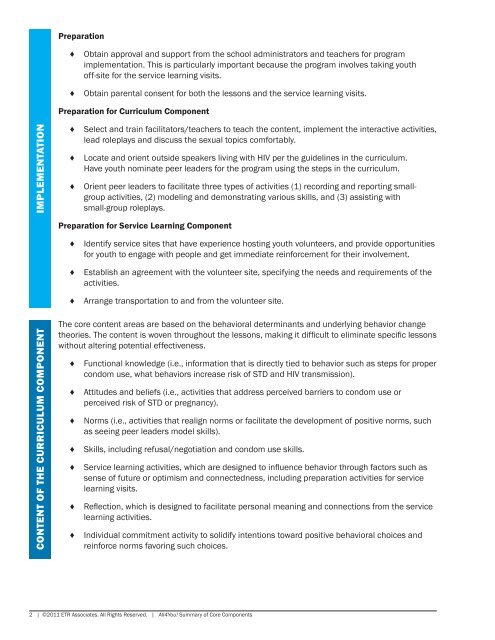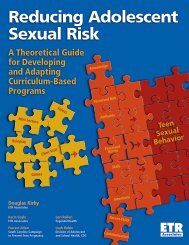Summary of Core Components - ETR Associates
Summary of Core Components - ETR Associates
Summary of Core Components - ETR Associates
- No tags were found...
Create successful ePaper yourself
Turn your PDF publications into a flip-book with our unique Google optimized e-Paper software.
Preparation♦♦♦♦Obtain approval and support from the school administrators and teachers for programimplementation. This is particularly important because the program involves taking youth<strong>of</strong>f-site for the service learning visits.Obtain parental consent for both the lessons and the service learning visits.Preparation for Curriculum ComponentIMPLEMENTATION♦♦♦♦♦♦Select and train facilitators/teachers to teach the content, implement the interactive activities,lead roleplays and discuss the sexual topics comfortably.Locate and orient outside speakers living with HIV per the guidelines in the curriculum.Have youth nominate peer leaders for the program using the steps in the curriculum.Orient peer leaders to facilitate three types <strong>of</strong> activities (1) recording and reporting smallgroupactivities, (2) modeling and demonstrating various skills, and (3) assisting withsmall-group roleplays.Preparation for Service Learning Component♦♦♦♦♦♦Identify service sites that have experience hosting youth volunteers, and provide opportunitiesfor youth to engage with people and get immediate reinforcement for their involvement.Establish an agreement with the volunteer site, specifying the needs and requirements <strong>of</strong> theactivities.Arrange transportation to and from the volunteer site.CONTENT OF THE CURRICULUM COMPONENTThe core content areas are based on the behavioral determinants and underlying behavior changetheories. The content is woven throughout the lessons, making it difficult to eliminate specific lessonswithout altering potential effectiveness.♦♦♦♦♦♦♦♦♦♦♦♦♦♦Functional knowledge (i.e., information that is directly tied to behavior such as steps for propercondom use, what behaviors increase risk <strong>of</strong> STD and HIV transmission).Attitudes and beliefs (i.e., activities that address perceived barriers to condom use orperceived risk <strong>of</strong> STD or pregnancy).Norms (i.e., activities that realign norms or facilitate the development <strong>of</strong> positive norms, suchas seeing peer leaders model skills).Skills, including refusal/negotiation and condom use skills.Service learning activities, which are designed to influence behavior through factors such assense <strong>of</strong> future or optimism and connectedness, including preparation activities for servicelearning visits.Reflection, which is designed to facilitate personal meaning and connections from the servicelearning activities.Individual commitment activity to solidify intentions toward positive behavioral choices andreinforce norms favoring such choices.2 | ©2011 <strong>ETR</strong> <strong>Associates</strong>. All Rights Reserved. | All4You! <strong>Summary</strong> <strong>of</strong> <strong>Core</strong> <strong>Components</strong>
















